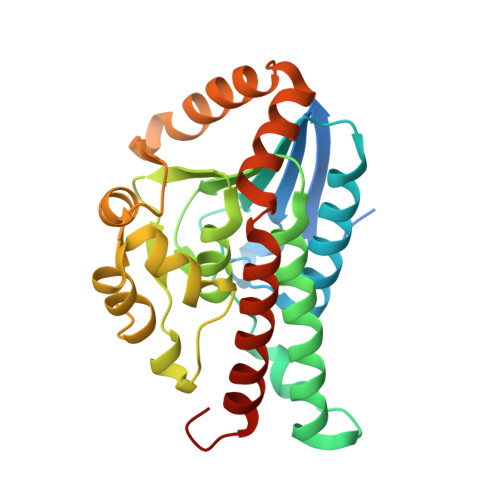Human Delta (3) , Delta (2) -enoyl-CoA isomerase, type 2: a structural enzymology study on the catalytic role of its ACBP domain and helix-10.
Onwukwe, G.U., Kursula, P., Koski, M.K., Schmitz, W., Wierenga, R.K.(2015) FEBS J 282: 746-768
- PubMed: 25515061
- DOI: https://doi.org/10.1111/febs.13179
- Primary Citation of Related Structures:
4U18, 4U19, 4U1A - PubMed Abstract:
The catalytic domain of the trimeric human Δ(3),Δ(2)-enoyl-CoA isomerase, type 2 (HsECI2), has the typical crotonase fold. In the active site of this fold two main chain NH groups form an oxyanion hole for binding the thioester oxygen of the 3E- or 3Z-enoyl-CoA substrate molecules. A catalytic glutamate is essential for the proton transfer between the substrate C2 and C4 atoms for forming the product 2E-enoyl-CoA, which is a key intermediate in the β-oxidation pathway. The active site is covered by the C-terminal helix-10. In HsECI2, the isomerase domain is extended at its N terminus by an acyl-CoA binding protein (ACBP) domain. Small angle X-ray scattering analysis of HsECI2 shows that the ACBP domain protrudes out of the central isomerase trimer. X-ray crystallography of the isomerase domain trimer identifies the active site geometry. A tunnel, shaped by loop-2 and extending from the catalytic site to bulk solvent, suggests a likely mode of binding of the fatty acyl chains. Calorimetry data show that the separately expressed ACBP and isomerase domains bind tightly to fatty acyl-CoA molecules. The truncated isomerase variant (without ACBP domain) has significant enoyl-CoA isomerase activity; however, the full-length isomerase is more efficient. Structural enzymological studies of helix-10 variants show the importance of this helix for efficient catalysis. Its hydrophobic side chains, together with residues from loop-2 and loop-4, complete a hydrophobic cluster that covers the active site, thereby fixing the thioester moiety in a mode of binding competent for efficient catalysis.
- Biocenter Oulu and Faculty of Biochemistry and Molecular Medicine, University of Oulu, Finland.
Organizational Affiliation:

















